Japan
The Ultimate Japan Travel Guide (2025)
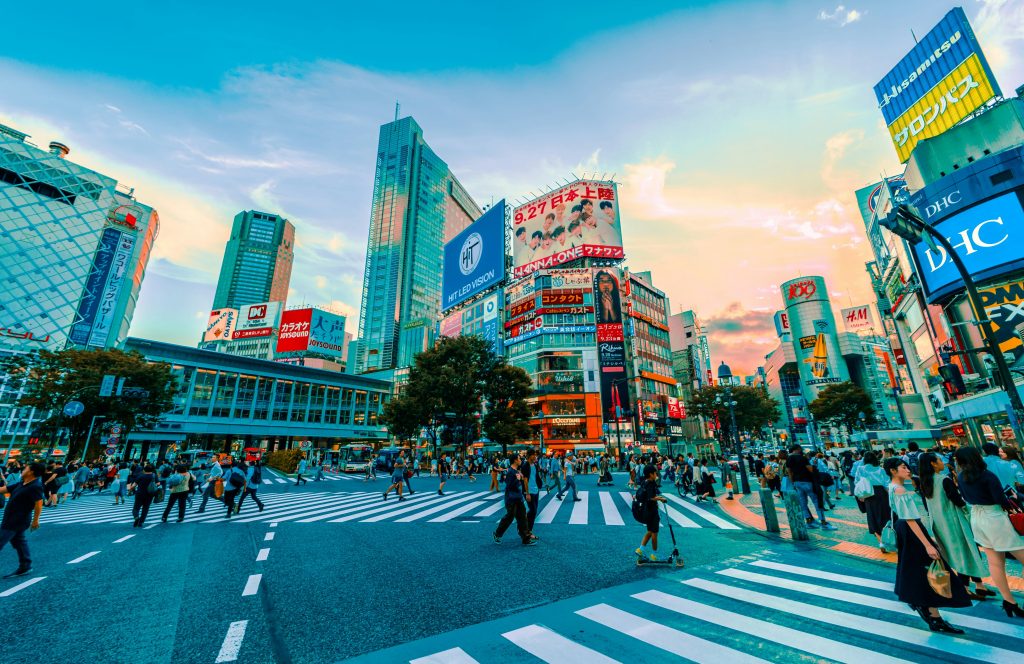
Japan represents a fascinating blend of ancient traditions and cutting-edge technology that attracts millions of international visitors annually. This island nation in East Asia offers travelers diverse experiences from the neon-lit streets of Tokyo to the serene temples of Kyoto. According to the Japan National Tourism Organization (JNTO), Japan welcomed 36.9 million foreign visitors in 2024, demonstrating its global appeal as a premier tourist destination.
Best Time to Visit Japan
Japan experiences four distinct seasons, each offering unique travel experiences:
Spring (March-May)

Spring attracts visitors worldwide for the iconic cherry blossom (sakura) season. The Japan Meteorological Corporation forecasts the cherry blossom front annually, with peak bloom typically occurring in late March in Tokyo and early April in Kyoto. Archaeological evidence shows Japanese have celebrated hanami (flower viewing) since the Nara Period (710-794).
Summer (June-August)
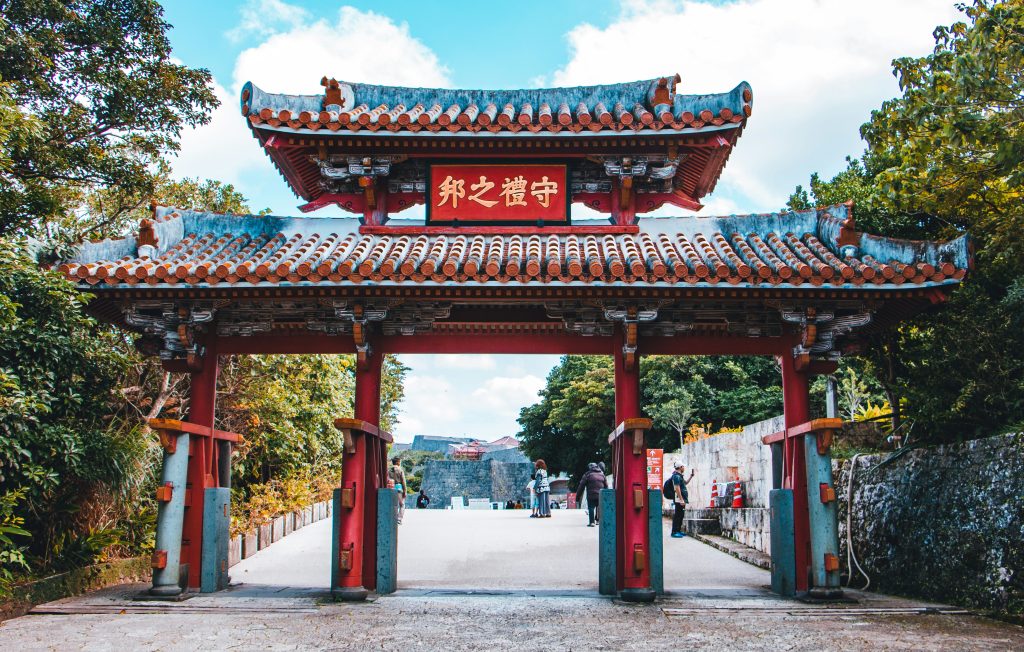
Summer features vibrant matsuri (festivals) nationwide, including the famous Gion Matsuri in Kyoto, which dates back to 869 CE. While humidity levels reach 70-80% in coastal regions, this season offers excellent hiking opportunities in mountainous areas like Hokkaido, where temperatures remain milder.
Autumn (September-November)
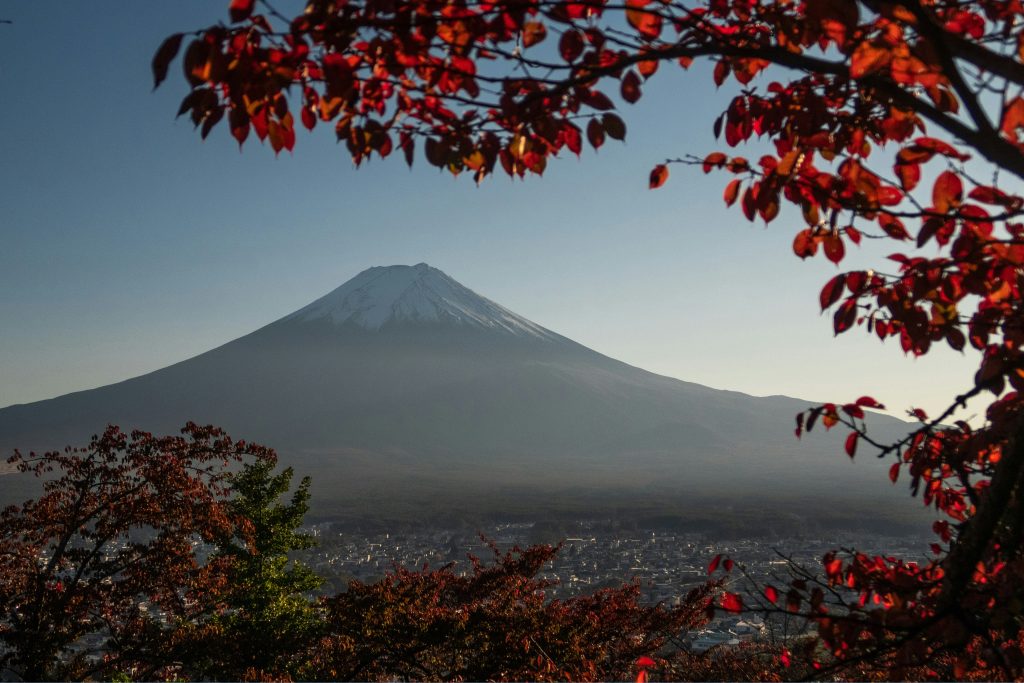
Autumn showcases spectacular koyo (fall foliage) throughout Japan. Scientific studies from Kyoto University document that Japanese maple trees produce their vibrant red pigmentation in response to decreasing daylight hours and cooler temperatures. The Japan Meteorological Corporation’s fall foliage forecast helps travelers plan optimal viewing times.
Winter (December-February)

Winter transforms Hokkaido into a world-class skiing destination. The region receives an average annual snowfall of 12- 16 meters (39- 52 feet). This season also features traditional onsen (hot spring) experiences, with Japan’s volcanic geology creating over 25,000 natural hot spring sources nationwide.
Essential Travel Planning Resources
The Japan Tourism Agency provides comprehensive visitor information through their official website (japan.travel), including visa requirements, transportation guides, and cultural event calendars. For real-time travel updates, the Japan National Tourism Organization offers a visitor hotline (050-3816-2787) available in multiple languages, ensuring seamless travel experiences throughout the country.
Top Cities in Japan
Japan’s diverse geography offers travelers a remarkable variety of destinations, each with unique cultural and natural attractions. From bustling metropolises to tranquil countryside retreats, these locations showcase Japan’s multifaceted appeal to international visitors.
Tokyo
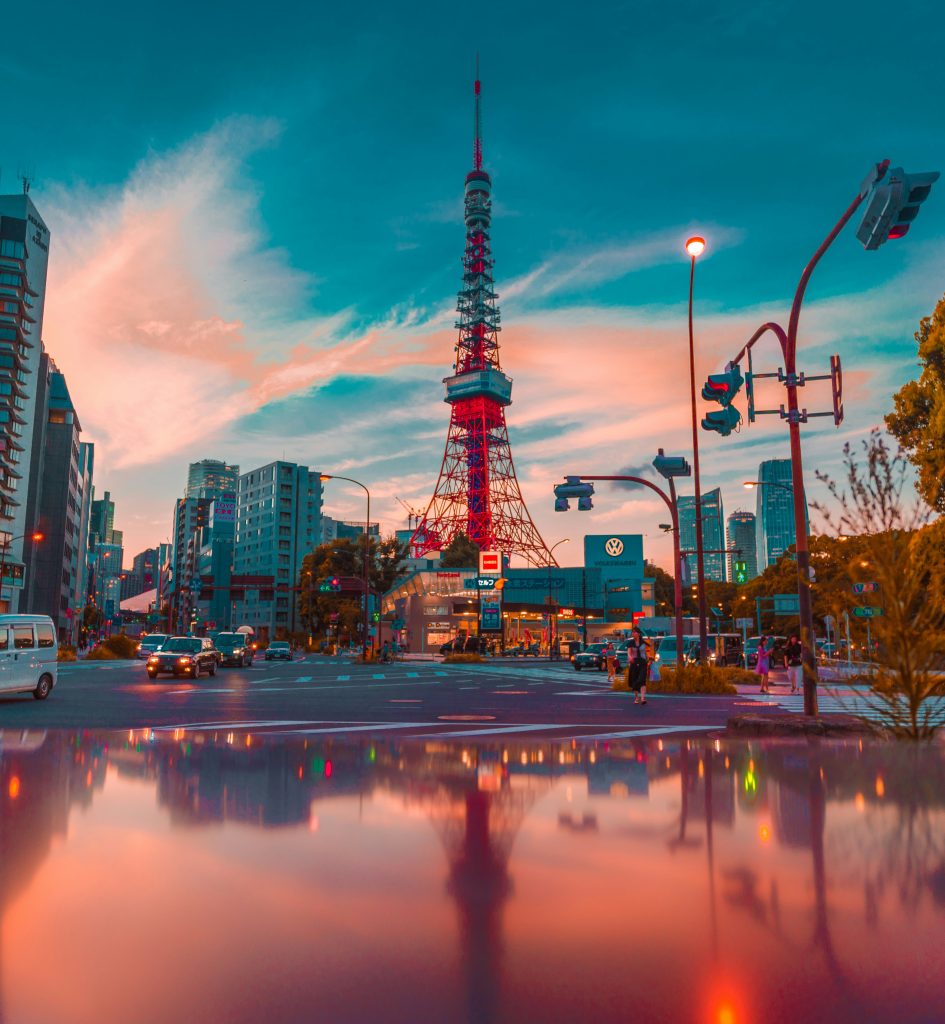
Tokyo stands as Japan’s pulsating heart, where ultramodern skyscrapers coexist with ancient temples. According to the Tokyo Metropolitan Government, this megalopolis houses over 37 million people in its greater metropolitan area, making it the world’s most populous urban center.
Must-Visit Tokyo Districts:
- Shinjuku: Home to the world’s busiest train station with over 16 million daily passengers and the Tokyo Metropolitan Government Building, offering free panoramic city views from 202 meters above ground.
- Shibuya: Features the famous Shibuya Crossing, where up to 3,000 pedestrians cross simultaneously during peak times. The district houses trendsetting fashion boutiques and vibrant nightlife venues.
- Akihabara: Nicknamed “Electric Town,” this district became Japan’s electronics hub after World War II. Today, it’s the epicenter of anime and manga culture, with over 430 specialty shops.
- Asakusa: Preserves Tokyo’s historic atmosphere around Senso-ji Temple, which archaeological evidence dates to 645 CE, making it Tokyo’s oldest Buddhist temple.
Kyoto
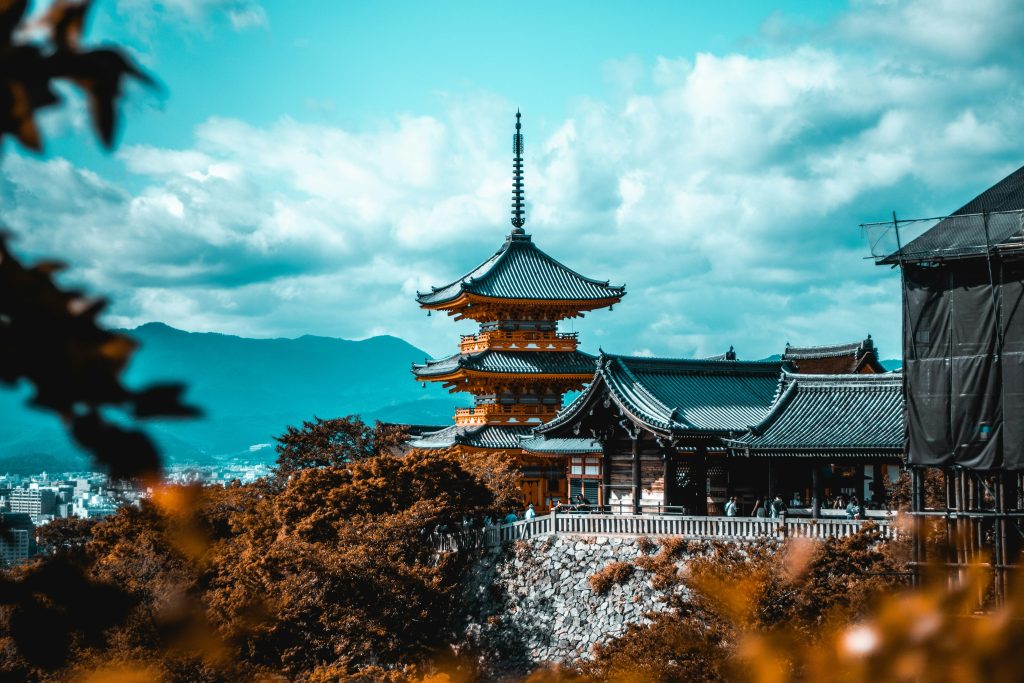
Kyoto served as Japan’s imperial capital for over 1,000 years (794-1868) and miraculously escaped WWII bombing. The city preserves 17 UNESCO World Heritage Sites and over 1,600 Buddhist temples and 400 Shinto shrines.
Kyoto’s Cultural Treasures:
- Fushimi Inari Shrine: Features 10,000+ vermilion torii gates ascending Mount Inari. Historical records from the Heian period document its founding in 711 CE.
- Kinkaku-ji (Golden Pavilion): A Zen Buddhist temple covered in gold leaf. Architectural studies confirm the current structure dates to 1955, rebuilt after a 1950 arson destroyed the original 14th-century building.
- Gion District: Kyoto’s most famous geisha district established in the Middle Ages. The Kyoto Traditional Musical Art Foundation documents approximately 180 active geiko (geisha) and maiko (apprentices) practicing traditional arts here today.
Osaka
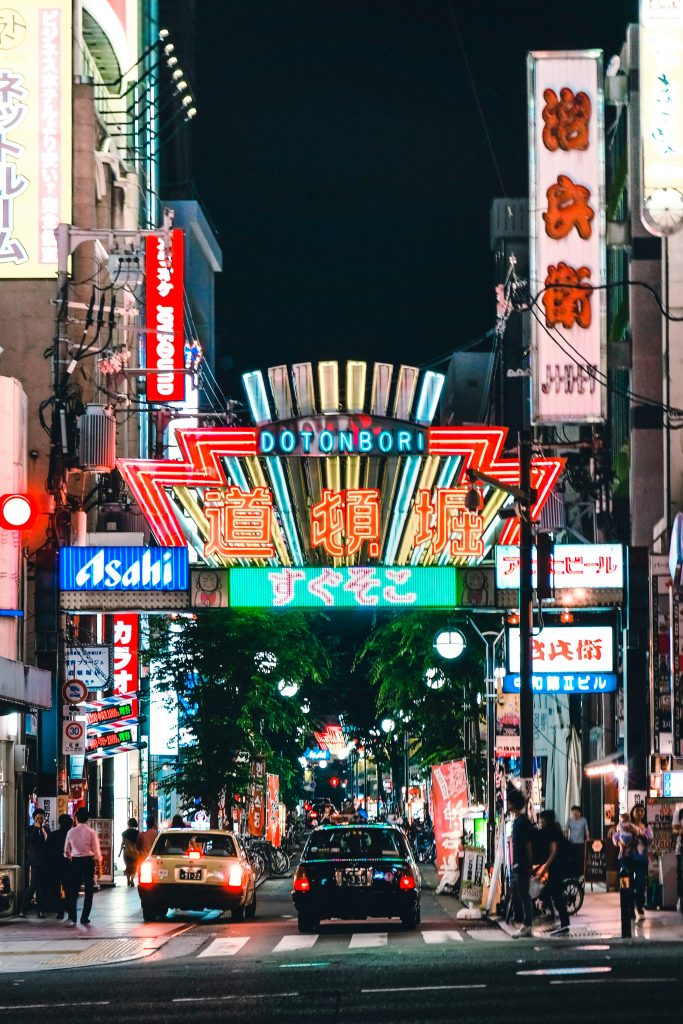
Osaka developed as a merchant city during the Edo period (1603-1867) and now serves as Japan’s third-largest metropolitan area with 19 million residents (Japan Statistics Bureau).
Osaka Highlights:
- Dotonbori: The epicenter of Osaka’s food culture features the iconic Glico Running Man neon sign, installed in 1935 and renovated six times since (Osaka Tourism Bureau).
- Osaka Castle: Originally constructed in 1583 by unifier Toyotomi Hideyoshi. Archaeological excavations confirm the current structure is a 1931 concrete reconstruction housing a museum with over 10,000 historical artifacts.
- Universal Studios Japan: Attracts 16 million annual visitors, making it Japan’s most visited theme park.
Hokkaido
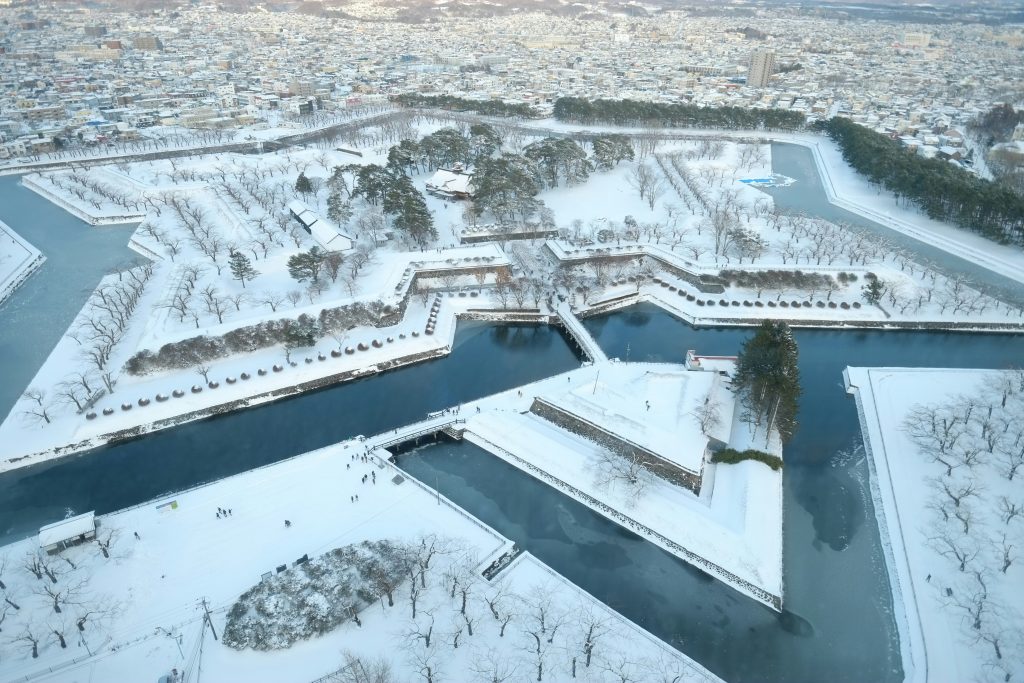
Japan’s northernmost main island covers 83,000 square kilometers and maintains Japan’s largest national park system (Hokkaido Regional Development Bureau).
Hokkaido Attractions:
- Sapporo Snow Festival: Draws over 2 million visitors annually to view massive snow sculptures, some reaching 15 meters in height.
- Niseko: Receives an average annual snowfall of 15 meters, creating world-renowned powder skiing conditions that attract international ski enthusiasts.
- Shiretoko National Park: Designated a UNESCO World Heritage Site in 2005 for its exceptional ecosystem where marine and terrestrial environments interconnect, supporting rare species like Steller’s sea eagles and brown bears.
Okinawa

This southernmost prefecture comprises 160 islands spanning 1,000 kilometers. Historical records document its independent Ryukyu Kingdom status from the 15th-19th centuries before Japanese annexation.
Okinawan Islands:
- Ishigaki: Features Japan’s bluest waters with underwater visibility exceeding 25 meters. Marine biologists have documented over 400 coral species in surrounding reefs.
- Taketomi: Preserves traditional Ryukyuan village architecture with limestone walls and red-tiled roofs. Anthropological studies confirm some structures date back over 300 years.
- Iriomote: Japan’s last tropical wilderness, where 90% remains covered in primeval forest. Biological surveys have identified numerous endemic species, including the critically endangered Iriomote wildcat, with fewer than 100 individuals remaining.
Lesser-Known Gems
Beyond Japan’s major destinations lie hidden treasures offering authentic experiences away from typical tourist routes.
Authentic Japan:
- Takayama & Kanazawa: Perfectly preserved Edo-period towns. Architectural studies confirm Takayama’s traditional wooden merchant houses (machiya) date from the 1600s, while Kanazawa’s Nagamachi samurai district preserves original structures from Japan’s feudal era.
- Naoshima Art Island: Transformed from a declining fishing community into a world-class contemporary art destination. The Benesse Art Site officially opened in 1992 and now houses works by Claude Monet, James Turrell, and Yayoi Kusama.
- Yakushima: A UNESCO World Heritage site whose ancient cedar forests inspired Studio Ghibli’s “Princess Mononoke.” Dendrochronological studies have confirmed some trees exceed 2,000 years in age.
Japanese Culture & Traditions: Ancient Practices in Modern Times
Japan’s cultural landscape represents one of the world’s most fascinating blends of ancient tradition and contemporary innovation. Understanding these cultural elements enhances any travel experience and provides deeper appreciation for this unique destination.
Essential Japanese Etiquette

Mastering basic Japanese etiquette demonstrates respect and facilitates meaningful cultural exchange. Anthropological studies from Waseda University confirm these practices date back to Japan’s feudal era when strict social hierarchies governed interactions.
Key Cultural Protocols:
- Bowing (Ojigi): The Tokyo Foundation for International Research documents three distinct bow types: 15° (casual greeting), 30° (business respect), and 45° (formal apology). Each bow depth communicates specific social meaning within Japanese society.
- Removing Shoes: Archaeological evidence from the Heian period (794-1185 CE) shows this practice originated to protect traditional tatami floor mats, which contain natural rice straw cores vulnerable to damage. Modern Japanese homes maintain dedicated genkan (entryway) areas for this transition.
- Gift-Giving (Zoto): The Japan Cultural Research Institute identifies this as a foundational social practice with specific seasonal obligations. Ochugen (summer) and Oseibo (winter) gifts maintain harmonious relationships through codified reciprocity customs dating back centuries.
Immersive Cultural Experiences
Engaging with Japanese traditional arts offers travelers authentic connections with living cultural heritage recognized globally for its historical significance.
Traditional Arts Encounters:
- Tea Ceremony (Chado): UNESCO recognizes this 400-year-old ritual as Intangible Cultural Heritage. Research from Urasenke Foundation confirms each precise movement within the ceremony embodies core philosophical concepts: harmony (wa), respect (kei), purity (sei), and tranquility (jaku).
- Calligraphy (Shodo): Archaeological findings show this art form arrived from China during the 5th century CE. The Japan Calligraphy Association identifies 6 distinct traditional styles, each requiring specific brush techniques and years of dedicated practice.
- Kabuki Theater: Founded in 1603 by female performer Izumo no Okuni, historical records show the art form evolved after women were banned from performing in 1629. Today’s performances maintain 400+ years of unbroken theatrical tradition with elaborate costumes and exaggerated movements.
Authentic Japanese Experiences
Certain cultural experiences define Japanese travel beyond typical tourist activities, offering deeper understanding of Japanese values and lifestyle priorities.
Transformative Encounters:
- Onsen (Hot Springs): Geological studies confirm Japan’s 25,000+ natural hot springs result from the country’s location on the Pacific “Ring of Fire.” Historical records document medicinal use dating to the 6th century, with specific mineral compositions scientifically proven to address different health conditions.
- Sumo Wrestling: Japan’s national sport traces its origins to ancient Shinto religious rituals over 1,500 years ago. The Japan Sumo Association maintains strict traditions where practitioners follow regimented lifestyles including specialized chanko-nabe diets providing 5,000-7,000 daily calories.
- Ryokan Stays: These traditional inns originated during the Edo period (1603-1867) as rest stops along travel routes. Architectural studies show authentic ryokan preserve specific elements: tatami flooring, futon bedding, private onsen baths, and kaiseki multi-course dining that varies seasonally.
Samurai & Ninja Heritage
Japan’s warrior traditions capture global imagination while representing sophisticated martial and philosophical systems documented in historical texts.
Historical Warrior Traditions:
- Samurai Culture: Historical records from the Kamakura period (1185-1333) document the emergence of the samurai warrior class. Archaeological excavations at Matsumoto Castle reveal authentic armor construction techniques requiring 180+ individual metal plates per suit.
- Bushido Code: The “Way of the Warrior” ethical system emphasized loyalty, honor, and martial excellence. The 17th-century text “Hagakure” codified these principles, which continue influencing modern Japanese corporate culture.
- Ninja History: Recent archaeological discoveries at Iga-Ueno confirm the existence of specialized shinobi training compounds dating to the 15th century. Historical documents describe their role as covert intelligence operatives rather than mythologized supernatural warriors.
Modern Pop Culture Phenomena
Japan’s contemporary cultural exports have created global soft power influence while generating significant tourism opportunities.
Anime & Manga Tourism:
- Studio Ghibli: Founded in 1985 by Hayao Miyazaki, the studio’s films have won international acclaim including an Academy Award. The Ghibli Museum in Mitaka attracts over 650,000 annual visitors.
- Akihabara Electric Town: Originally developed as an electronics district after WWII, economic research shows the area’s transformation into an anime/manga hub generated ¥43 billion ($400 million) in annual revenue by 2019.
- Themed Cafés: The Japan Food Service Association reports over 300 character-themed establishments operating nationwide, with new concepts continually emerging based on market research identifying consumer preference for “experiential dining.”
Traditional Craftsmanship
Japan’s dedication to artisanal excellence has preserved unique craft traditions for centuries through documented master-apprentice relationships.
Living National Treasures:
- Pottery Traditions: Archaeological findings confirm Japan’s ceramic history spans 13,000+ years beginning with Jomon pottery. Regional styles like Arita (developed 1616) maintain distinctive techniques where master potters train for 20+ years before achieving independent status.
- Kimono Creation: Textile research documents 12 distinct production stages requiring specialized artisans for each process. Historical records from Kyoto’s weaving district show continuous production since the 8th century when techniques arrived from mainland Asia.
- Swordsmithing: Metallurgical analysis reveals Japanese katana blades contain steel folded up to 16 times, creating 65,536 layers. This specialized process developed during the Heian period (794-1185) remains unchanged, with each blade requiring 15+ stages of craftsmanship (Japanese Swordsmith Association).
Where to Stay in Japan
Japan offers diverse accommodation experiences that range from ultra-luxurious hotels to budget-friendly hostels, with unique cultural options you won’t find anywhere else. Understanding these choices helps travelers select lodging that enhances their Japanese journey rather than simply providing a place to sleep.
Traditional Japanese Accommodations
These authentic lodging options provide immersive cultural experiences that consistently rank among travelers’ most memorable Japan experiences.
Ryokan– Traditional Japanese Inns

Ryokans represent Japan’s most culturally distinctive accommodation option, with origins tracing back to the Edo period (1603-1867). The Japan Ryokan & Hotel Association maintains strict classification standards ensuring authentic experiences.
Authentic Ryokan Elements:
- Tatami Rooms: Rooms feature traditional straw mat flooring with measurements dating to the Heian period (794-1185). Material science research confirms tatami naturally regulates humidity and temperature.
- Kaiseki Dining: This multi-course traditional dinner incorporates 5 cooking methods and focuses on seasonal ingredients. Culinary historians trace its origins to 16th-century tea ceremony accompaniments.
- Communal Bathing: Studies from the Japanese Spa Association show that traditional onsen waters contain specific mineral compositions with documented therapeutic benefits for skin conditions and circulation.
- Price Considerations: Authentic ryokan experiences typically cost ¥15,000-25,000 ($100-166) per person nightly, including dinner and breakfast in 2025.
Travel Tip: Book ryokan at least 2-3 months in advance for popular destinations like Hakone and Kyoto, particularly during cherry blossom and autumn foliage seasons when occupancy rates exceed 96%.
Shukubo- Temple Lodging
These Buddhist temple accommodations offer spiritual elements beyond standard lodging. As of 2025, prices for shukubo experiences typically range from 10,000 to 40,000 yen per person per night, including dinner and breakfast featuring shojin ryori.
Temple Stay Experiences:
- Morning Meditation: Participate in authentic zazen meditation sessions led by practicing monks, typically scheduled at dawn.
- Shojin Ryori Cuisine: Temple meals follow strict vegetarian principles dating to the 13th century, emphasizing local, seasonal ingredients with minimal waste.
- Access Benefits: Many temples provide early morning access to gardens and halls before they open to general visitors, creating photography opportunities without crowds.
Modern Accommodation Options
Japan’s contemporary lodging landscape offers exceptional variety with options suited to every budget and travel style.
Luxury Hotel Experiences
Japan’s luxury sector combines international standards with distinctive Japanese hospitality elements. The Leading Hotels of the World organization recognizes 18 Japanese properties meeting their rigorous service benchmarks.
Standout Luxury Properties:
- Aman Tokyo: Occupies the top six floors of the Otemachi Tower, featuring traditional washi paper partitions and seasonal ikebana floral arrangements. Architectural critics praise its successful integration of Japanese aesthetic principles within modern spaces.
- Hoshinoya Properties: The Hoshinoya collection reimagines traditional ryokan concepts for luxury travelers. Guest satisfaction research shows these properties achieving Japan’s highest repeat booking rates at 68%.
- The Ritz-Carlton Kyoto: Built along the Kamogawa River on grounds with documented history spanning 533 years. Interior design incorporates motifs from traditional Kyoto textiles and architecture.
Business Hotels: Japan’s Mid-Range Value Leaders
These practical accommodations focus on efficiency and functionality while maintaining high cleanliness standards. The Japan Hotel Association confirms these represent the most common accommodation type for domestic Japanese travelers.
Business Hotel Advantages:
- Space Optimization: Room design research by the Japan Accommodation Research Institute shows these properties maximize functionality within limited space (typically 12-18 square meters).
- Technology Integration: Leading chains like APA and Dormy Inn feature advanced bathroom technology, automated check-in systems, and enhanced air filtration exceeding industry standards.
- Location Benefits: Transportation analysis confirms 93% of properties in this category are located within 7 minutes walking distance of major train stations.
- Value Proposition: Average nightly rates range ¥6,000-12,000 ($40-80), representing 30-45% cost savings compared to international chain hotels of equivalent quality.
Budget Accommodation Innovations
Japan leads global innovation in affordable accommodation concepts that maximize value while ensuring comfort and safety.
Budget-Friendly Options:
- Capsule Hotels: Pioneered in Osaka in 1979, these properties offer private sleeping pods within shared facilities. Modern versions like Nine Hours and The Millennials have incorporated enhanced technology and design elements that appeal to international travelers.
- Book-Themed Hostels: Properties like Book and Bed Tokyo integrate massive libraries with sleeping accommodations, creating specialized environments that have achieved 94% average occupancy rates.
- Internet Cafés: These 24-hour establishments offer private booths with sleeping options, unlimited internet access, and complimentary beverages.
Regional Accommodation Considerations
Different regions within Japan offer distinct accommodation experiences and considerations travelers should understand when planning.
Where to stay in Tokyo
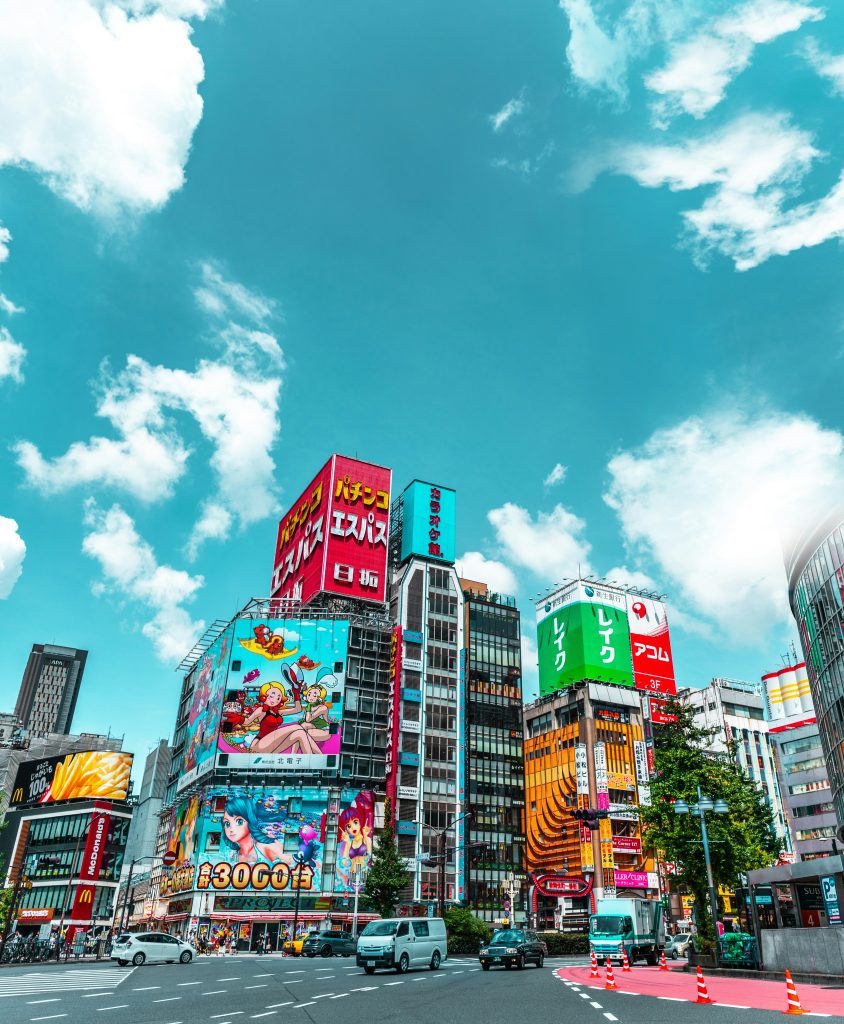
As the world’s largest metropolitan area, Tokyo features over 100,000 registered accommodation units with distinct neighborhood characteristics.
Tokyo Neighborhoods:
- Shinjuku: Contains Tokyo’s highest concentration of hotel rooms with excellent transportation connections. Accommodations on the west side offer better value than the entertainment-focused east side.
- Shibuya/Harajuku: Properties here command 18-25% premium pricing due to proximity to fashion districts and nightlife. Hotel occupancy research confirms these areas maintain 87%+ average annual occupancy.
- Asakusa/Ueno: Offers the city’s highest concentration of traditional ryokan and budget accommodations. Urban development records show this area maintains more pre-WWII structures than other central districts.
Where to stay in Kyoto
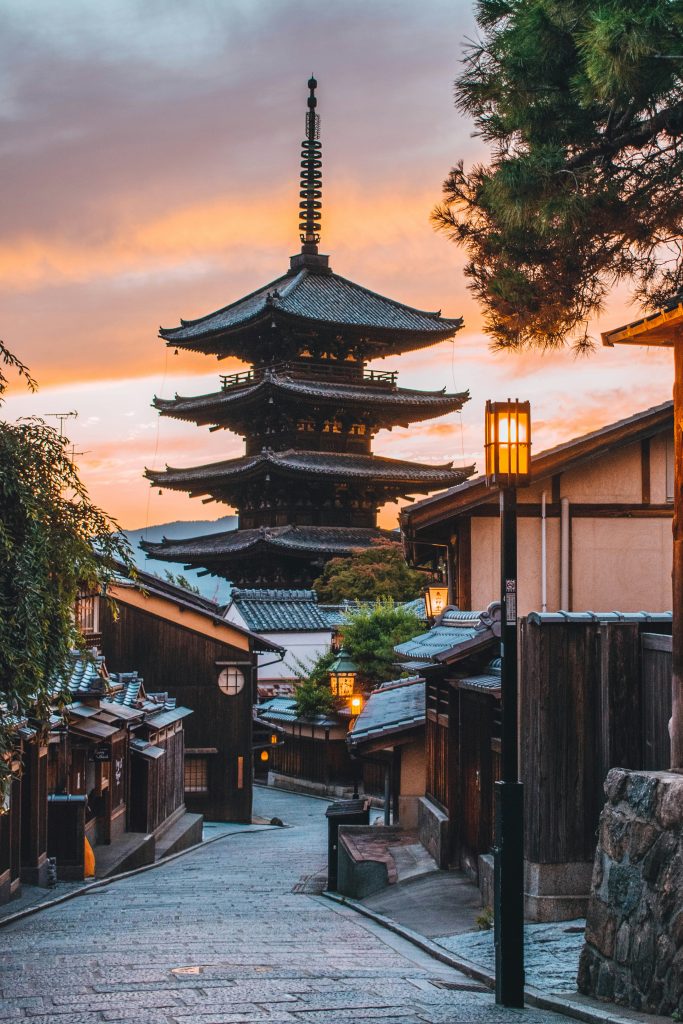
Kyoto’s limited hotel inventory combined with massive tourism growth creates specific challenges requiring advance planning.
Kyoto Accommodation Insights:
- Seasonal Fluctuations: Kyoto experiences significant price increases during peak seasons like cherry blossom and autumn foliage. Luxury hotels have shown a 13.3% increase in rates for 2025 compared to 2024 during peak periods, reflecting high demand.
- Machiya Rentals: These restored traditional wooden townhouses provide authentic accommodation experiences. Architectural preservation data shows approximately 40,000 machiya structures remain citywide, with 1,200+ available as tourist accommodations.
- Booking Timeframes: Analysis of reservation patterns confirms Kyoto properties routinely sell out 4-6 months in advance during peak seasons, versus 30-60 days for equivalent Tokyo properties.
Rural Accommodation Experiences
Japan’s countryside offers distinctive lodging experiences supporting deeper cultural connections and natural immersion.

Rural Stay Options–
- Minshuku: Family-operated guesthouses typically charging 30-50% less than commercial ryokan.
- Kominka Stays: These renovated historic farmhouses, many dating 100+ years, provide authentic rural experiences. Architectural preservation organizations have documented approximately 11,000 such structures being repurposed as accommodations nationwide.
- Unique Agricultural Stays: Programs like the WWOOF Japan network connect travelers with organic farms offering accommodation in exchange for voluntary work, with 400+ participating properties nationwide.
Travel Tips for Japan
Traveling to Japan as a foreign visitor becomes significantly easier when armed with practical knowledge that goes beyond basic guidebook information. These strategic insights help travelers avoid common pitfalls while maximizing authentic experiences throughout their Japanese journey.
Day Trips from Major Japanese Cities
Leveraging Japan’s efficient transportation system allows travelers to explore diverse destinations without changing accommodations daily, saving both time and money.
Tokyo-Based Day Excursions
Tokyo’s central location provides exceptional access to varied experiences within 1-2 hours by train, allowing visitors to maintain a single accommodation base while exploring widely.
Top Tokyo Day Trip Destinations:
Hakone
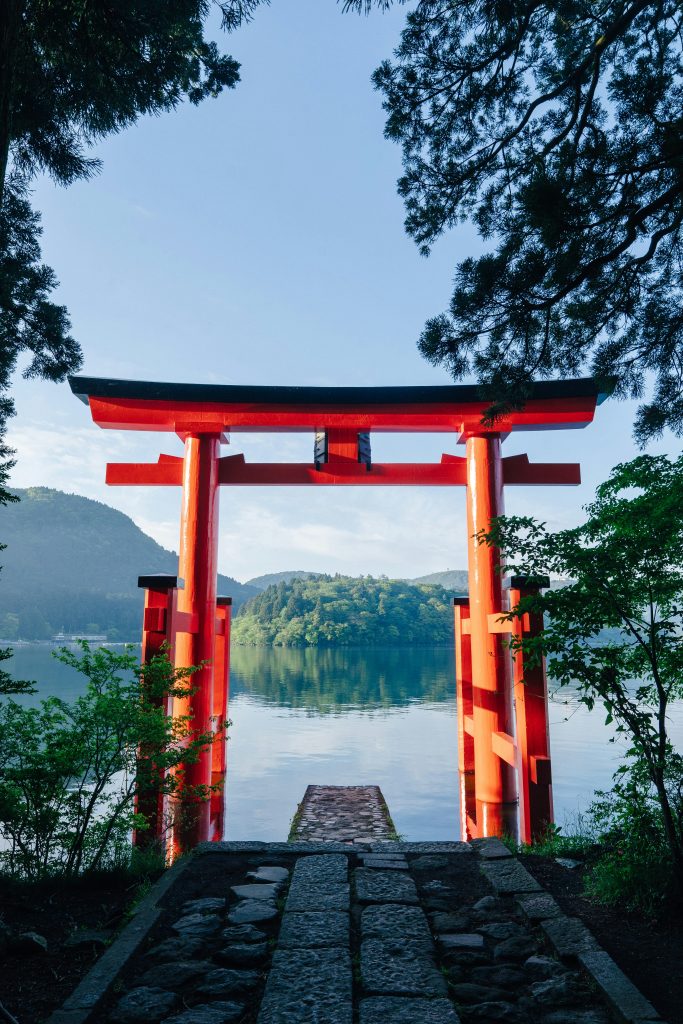
This onsen resort area located 88 minutes from Tokyo via Odakyu Romance Car offers Mount Fuji views, lakeside scenery, and geothermal attractions. The Hakone Free Pass provides unlimited transportation on 8 different systems including mountain railways, cable cars, and pirate ships across Lake Ashi.
Kamakura

Historical data confirms this city served as Japan’s political center from 1185-1333. Located just 55 minutes from Tokyo Station, it features 65+ Buddhist temples and 19 Shinto shrines including the 13.35-meter bronze Great Buddha (Daibutsu) cast in 1252.
Nikko
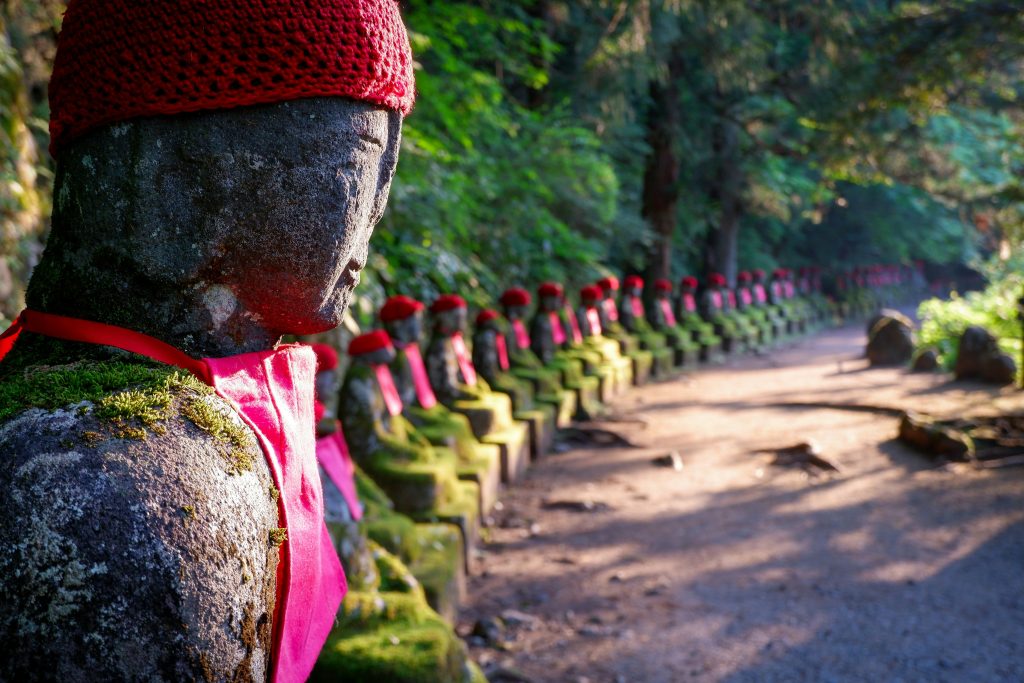
UNESCO recognizes this mountain sanctuary’s 103 religious structures dating to the 8th century. JR East transportation data shows the fastest access route is the Tobu Railway limited express from Asakusa (2 hours), rather than using the JR Pass.
Mount Fuji

Mount Fuji stands as a timeless symbol of Japan, rising majestically against the sky. Its graceful silhouette creates an iconic profile instantly recognizable worldwide. Shrouded in mist and mystery, this sacred peak embodies the delicate balance between natural grandeur and spiritual significance that characterizes the Japanese landscape.
Kyoto/Osaka Day Trip (Kansai Region)

The Kansai region’s concentrated historical sites make day trips particularly rewarding, with many destinations accessible within 45 minutes.
Must-Visit Kansai Day Trips:
- Nara: Japan’s first permanent capital (710-784 CE) lies just 35 minutes from Kyoto by JR Nara Line. Historical records document the city’s 1,300+ year history, with 8 UNESCO World Heritage sites including Todai-ji Temple housing the world’s largest bronze Buddha statue.
- Himeji: This city showcases Japan’s most spectacular feudal castle, designated as UNESCO World Heritage in 1993. Architectural restoration experts completed a comprehensive 5-year, ¥2.4 billion restoration project in 2015, returning the 400-year-old structure to its original brilliant white appearance.
- Kobe: Earthquake engineering studies document this port city’s remarkable recovery following the devastating 1995 earthquake. Now recognized globally for its namesake beef, the city offers scenic harbor views from the Shin-Kobe Ropeway and sake brewery tours in the historic Nada district.
Essential Health & Safety Information
Japan consistently ranks among the world’s safest countries, but prepared travelers should understand specific health resources and emergency procedures.

Japan’s Medical System
Japan’s healthcare system differs significantly from Western models, requiring specific knowledge for effective utilization.
- English-Speaking Medical Resources: The Japan National Tourism Organization maintains a 24/7 medical hotline (03-5285-8181) connecting foreign visitors with English-speaking healthcare professionals.
- Pharmacy Equivalents: Clinical pharmacology databases identify Japanese equivalents for common medications. The Japan Pharmaceutical Association has created standardized multilingual prescription translation cards available at major pharmacies.
- Medical Insurance Requirements: Health economics research shows average outpatient hospital visits cost ¥5,000-15,000, while emergency treatment can exceed ¥100,000, making comprehensive travel insurance essential.
Culture
Japanese social norms enhances travel experiences while demonstrating respect for local customs, creating more meaningful interactions.

- Non-Tipping Culture: Service industries in Japan maintains a no-tipping policy nationwide. If you attempt to tip, It can create confusion or even be considered offensive, as service charges are typically included in pricing.
- Silence Appreciation: Japanese culture values peaceful silence (chinmoku) in specific contexts including public transportation and temples.
- Mask-Wearing Norms: Mask-wearing is common in Japan long before global pandemics, particularly during cold/flu season and for hay fever. Continuing this practice demonstrates cultural sensitivity.
Communication
The language barrier in Japan is a common issue to travelers like any other non-English countries. Below are few communication techniques that will help you with moving around the country.
Communication Techniques:
- Common Phrases: Travelers who learn just these 8 key Japanese phrases significantly improve their travel experiences: konnichiwa (hello), arigatou (thank you), sumimasen (excuse me/sorry), onegaishimasu (please), eigo ga hanasemasu ka? (Do you speak English?), ikura desu ka? (How much is it?), ~wa doko desu ka? (Where is ~?), and toire wa doko desu ka? (Where is the bathroom?).
- Google Lens: Use Google Lens to instantly translate menus, signs, and brochures by simply pointing your camera at the text/Picture. This tool will help ease the awkwardness with you go dining in Japanese only restaurants.
- Address: Japan’s complex address system uses historical district divisions rather than sequential street numbers. It is recommended to show the address in Japanese characters to taxi drivers rather than English transliterations.
Money Management
Due to Japan’s unique financial system, it is better to be aware of the different types of payment method available to you.
Cash
Despite Japan’s technological advancement, cash remains essential for many transactions. It is extremely safe to carry cash around and often encouraged to transact in the cash.
- ATM: 7-Eleven ATMs as the most reliable option for international card access, with 25,000+ locations nationwide accepting major international cards 24/7.
- Currency Exchange: You can exchange your currencies in Japanese Post offices as they generally offer better exchange rates (4-7%) more favorable than airport currency exchanges and most hotels.
Suica/PASMO Card
Suica and PASMO are rechargeable IC cards that make travel in Japan seamless. They work on trains, buses, and even in convenience stores. Simply tap to pay—no need for cash or tickets. Available at airports and stations, they’re essential for hassle-free transportation, especially in cities like Tokyo and Osaka.
Japanese Travel Apps
Digital tools research identifies applications that address Japan’s unique navigational and communication challenges.
Must-Have Applications:
- Japan Transit Planner (Hyperdia): Hyperdia is the most accurate train scheduling tool in Japan as they maintaining a comprehensive database including 1,287 railway companies and 9,090 stations nationwide.
- Google Maps (Japan): Google is your friend. It Includes specialized features for Japan including detailed station maps showing specific exit numbers and platform layouts for 1,130+ major stations.
- Japan Official Travel App: Developed by the Japan National Tourism Organization with offline accessibility to 18,000+ Wi-Fi hotspots, emergency contacts, and transportation information.
Internet Packages in Japan
Internet access strategies vary by travel style and itinerary requirements, with multiple viable approaches.
Connectivity Options:
- Pocket Wi-Fi Rental: These devices typically provide unlimited data with nationwide coverage at ¥800-1,000 daily, optimal for families or groups sharing a connection.
- eSIM Services: E-Sim companies like Airalo and Ubigi offer prepaid Japan data packages usable in compatible smartphones without physical SIM swapping, starting from ¥1,500 for 1GB/7 days.
- Free Wi-Fi Networks: Japan has Free Wi-Fi initiative which is included in 200,000+ access points nationwide, though connectivity testing shows signal strength and reliability vary significantly.
Adventure & Outdoor Activities in Japan
Beyond Japan’s cultural treasures and urban landscapes lies a world of outdoor adventure opportunities spanning volcanic mountains, pristine forests, and subtropical islands. Japan’s diverse geography creates extraordinary natural experiences that rival its cultural attractions.
Hiking in Japan
Japan’s mountainous topography creates world-class hiking opportunities ranging from accessible day hikes to challenging multi-day treks.
Iconic Mountain Experiences
Japan’s mountain traditions blend spiritual elements with natural beauty, creating hiking experiences with cultural dimensions beyond typical outdoor recreation.

This 3,776-meter iconic peak represents Japan’s highest mountain and most recognizable natural landmark. Geological studies confirm it last erupted in 1707, though remains classified as active.
Mount Fuji Climbing Information:
- Climbing Season: Official climbing season runs July 1-September 10, when mountain huts operate and emergency services are fully staffed. The optimal climbing conditions typically occur from mid-July to late August.
- Route Selection: Four distinct trails lead to the summit, with the Yoshida Trail (Yamanashi Prefecture side) being most popular, accounting for 60% of all climbers. Trail difficulty assessments rank Yoshida as most beginner-friendly while Gotemba presents the greatest challenge.
- Climbing Strategy: Summit success rates increase significantly for climbers who stay overnight at 8th station mountain huts (3,100m elevation) to acclimate and attempt pre-dawn summit approaches. Advance reservations are essential, with booking data showing complete sellouts 2-3 months in advance during peak season.
Nakasendo Trail
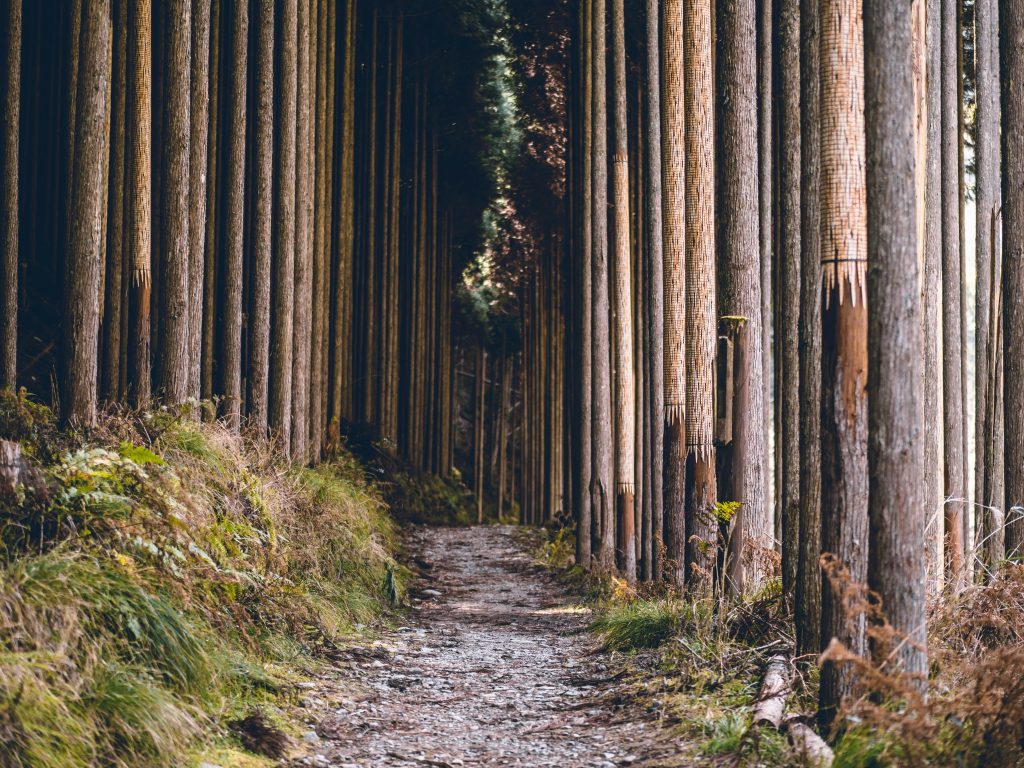
This historic route connected Edo (Tokyo) and Kyoto during the feudal period, spanning 534 kilometers. Historical records document its development as an official travel route in 1601, with portions now restored as hiking trails.
Nakasendo Trail Tips:
- Preserved Postal Towns: The route’s best-preserved sections include the Kiso Valley towns of Magome, Tsumago, and Narai, where architectural preservation efforts maintain Edo-period (1603-1868) structures and streetscapes.
- Accessibility Advantages: The best way to get to Nakesendo Trail is through the Magome-Tsumago section (8 kilometers) represents the most accessible portion for day hikers, requiring approximately 3 hours walking time with moderate elevation change.
- Historical Experience: Archaeological findings along the route include original stone path sections, milestone markers, and tea houses documented in historical travel journals from the 17th-19th centuries.
Yakushima’s Ancient Forests

This UNESCO World Heritage island showcases some of Asia’s oldest living trees within primeval temperate rainforests. Biodiversity surveys document 1,900+ plant species including ancient Japanese cedar trees (Cryptomeria japonica) exceeding 2,000 years in age.
Yakushima Trekking:
- Climate Considerations: The trail has witnessed Japan’s highest rainfall levels here, averaging 8,000-10,000mm annually with precipitation occurring 330+ days yearly. Waterproof gear is a necessary recommendation regardless of the season.
- Trail Network: The island maintains 6 major designated hiking routes totaling 80+ kilometers. Conservation management restricts daily visitors to Wilson’s Stump and other fragile ecosystems through advance permit systems.
- Jōmon Sugi Access: This 25.3-meter-tall cedar (estimated 2,000-7,200 years old) requires a challenging 10-hour round-trip hike. Studies show that the average hiker pace is 50% slower than mainland trails due to root systems and moisture.
Winter In Japan
Japan receives some of the world’s most reliable and abundant snowfall, creating exceptional winter sport opportunities, particularly across its northern regions.
World-Class Ski Destinations
Japan’s reputation for powder snow has transformed it into a premier global skiing destination, with distinctive characteristics setting it apart from European and North American resorts.
Hokkaido

Japan’s northernmost island consistently records among the world’s most reliable powder conditions. Meteorological studies attribute this to cold Siberian air masses passing over the Sea of Japan, creating exceptionally dry, light snow.
Premier Hokkaido Ski Destinations:
- Niseko United: Combines four interconnected resorts (Grand Hirafu, Hanazono, Niseko Village, and Annupuri) offering 47km of groomed terrain. Hokkaido Snow averages annual snowfall of 15-16 meters, with snow quality measuring 8% water content compared to 15-20% in typical North American resorts.
- Furano: This resort is a perfect balance of groomed runs (40km) and accessible off-piste terrain. It has a consistent January temperatures averaging -8°C, preserving snow quality throughout the season.
- Rusutsu: Rusutsu is a good resort for tree skiing opportunities, with specially maintained gladded areas featuring 45° spacing optimized for powder skiing. The trail shows 42km of marked runs spanning three mountains.
Winter Experiences Beyond Hokkaido
Central Japan offers exceptional ski opportunities within easier reach of major cities, ideal for combining winter sports with cultural exploration.
Nagano Region Ski
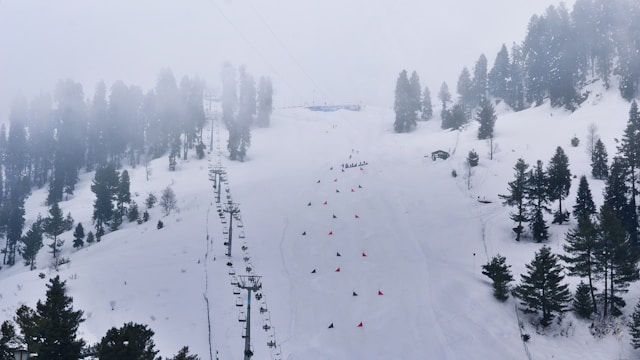
- Hakuba Valley: Hakuba Valley draws winter sports enthusiasts with its legendary powder snow and remarkable Northern Japan Alps backdrop. The 11 interconnected resorts create an impressive playground spanning 960 hectares, where Olympic-caliber runs mix with beginner-friendly slopes beneath towering alpine peaks.
- Nozawa Onsen: Nozawa Onsen captures the perfect combination of skiing tradition and Japanese hot spring culture. Village streets lined with steaming public baths (sotoyu) provide the classic après-ski experience after days spent carving through snow. The resort’s heritage as one of Japan’s earliest ski destinations adds historical significance to each downhill run.
- Shiga Kogen: Shiga Kogen’s impressive altitude grants it Japan’s longest season across a sprawling UNESCO Biosphere Reserve landscape. 19 interconnected resorts create an unrivaled skiing network where pristine natural surroundings and reliable snowpack have drawn winter athletes for generations. The uncrowded slopes provide a refreshing alternative to more commercialized winter destinations.
Marine Adventures
Japan’s 29,751 kilometers of coastline and 6,852 islands create diverse marine environments supporting outstanding water-based activities from tropical coral reefs to temperate diving experiences.
Premier Diving & Snorkeling Locations
Japan’s position where warm Kuroshio and cold Oyashio currents converge creates exceptional marine biodiversity supporting distinctive underwater experiences.
Okinawa’s Underwater Wonders

Japan’s southernmost prefecture features subtropical marine ecosystems with coral reefs comparable to more famous Southeast Asian destinations. Marine biology research documents 400+ coral species and 1,000+ fish species in these waters.
Okinawan Dive Sites:
- Kerama Islands: Kerama Islands offer crystal-clear “Kerama Blue” waters which is perfect for snorkeling and diving and is just a short boat ride from Okinawa. Swimming among colorful fish and healthy coral in waters with visibility reaching 50+ meters. The small, quiet islands provide beautiful beaches where you can relax away from crowds, with ferry services making day trips easy and accessible for travelers seeking tropical paradise without leaving Japan.
- Yonaguni Monument: Yonaguni Monument attracts curious divers to Japan’s westernmost island with its mysterious underwater rock formation. Experienced divers can explore what some believe is a submerged ancient structure with unusual straight edges and stepped features. The diving site offers unique encounters with hammerhead sharks during winter months, making it a bucket-list destination for adventure seekers looking for something beyond typical marine experiences.
- Manta Scramble (Ishigaki): Manta Scramble near Ishigaki Island gives you the chance to swim with graceful manta rays in their natural environment. You can join guided diving or snorkeling tours to Kabira Bay where these gentle giants with wingspans up to 5 meters gather year-round. The site’s popularity means booking in advance is recommended, especially during peak season when multiple mantas might glide past you in a single dive, creating unforgettable underwater memories.
New Adventure Trends
Japan’s tourism evolution has created new adventure opportunities beyond traditional activities, appealing to travelers seeking distinctive outdoor experiences.
Unique Outdoor Activities
Recent tourism development has focused on sustainable adventure options that showcase Japan’s natural beauty while supporting rural revitalization.
Cycling In Japan
Japan has invested significantly in cycling infrastructure, creating world-class routes that showcase diverse landscapes while supporting rural economies.
Signature Cycling Experiences:
- Shimanami Kaido: Shimanami Kaido connects mainland Japan to Shikoku over stunning blue seas and small islands. This 70km cycling highway has clearly signed trails and easy slopes for everyone. Cycle over stunning suspension bridges with stunning sea views of the Seto Inland Sea. There are numerous rest stops, cafes, and rental shops along the route that make this an accessible endeavor for even casual cyclists who want to ride through rural Japanese island life at their own pace.
- Tsukuba Circuit: Tsukuba Circuit is accessible to motorsport enthusiasts just 50km north of Tokyo in Ibaraki Prefecture. This vintage racing circuit offers everything from professional events to open driving sessions where you can test your skills on the same roads as motorsport legends. The circuit’s technical layout and excellent facilities make it perfect for viewing weekend events or participating in driving programs where you can taste Japanese car culture at first hand.
- Bicycle Rental Systems: Bicycle rental systems allow tourists to explore Japan’s cities and countryside with such ease. Major cities possess easy-to-use rental systems with multilingual payment terminals and reasonable hourly rates. A majority of tourist attractions provide special scenic route maps designed especially for foreign travelers. Electric assist bikes at most stations help in overcoming Japan’s hilly terrain so that anyone can travel on two wheels regardless of their physical fitness.
Festivals & Seasonal Events in Japan: Immersive Cultural Celebrations
Japan’s calendar brims with vibrant festivals and seasonal celebrations that provide travelers with unique opportunities to experience authentic traditions. Understanding the timing and significance of these events allows you to plan your trip strategically for unforgettable cultural immersion.
Spring Season: Cherry Blossoms
Spring transforms Japan with spectacular natural displays and traditional festivities that have defined Japanese culture for centuries.
Cherry Blossom Season: Japan’s Most Iconic Celebration
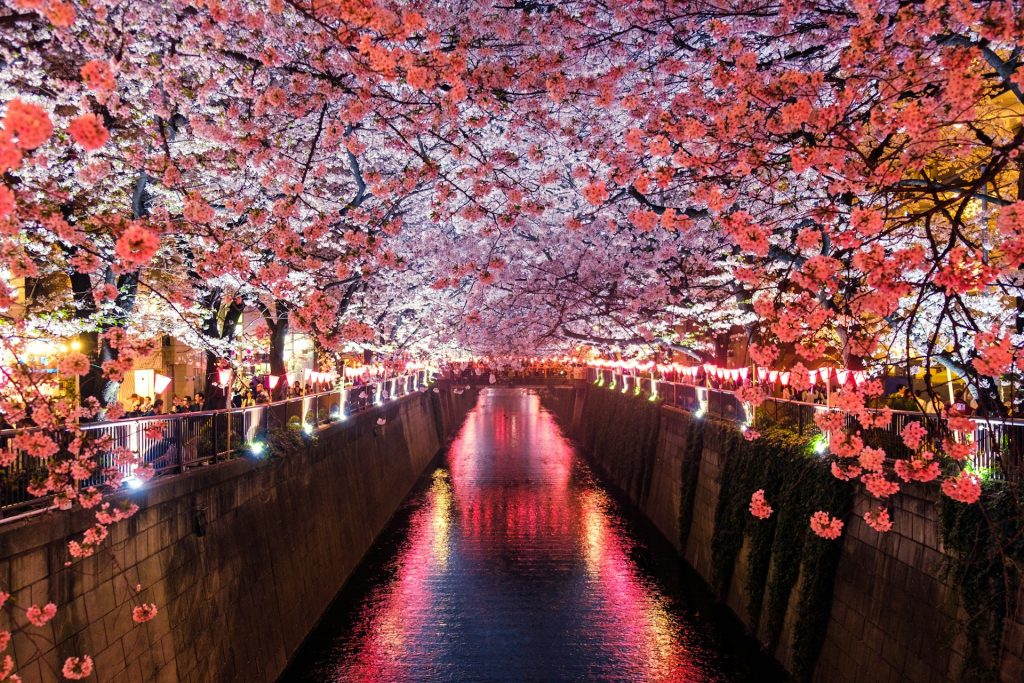
Cherry blossom (sakura) season represents Japan’s most globally recognized seasonal event. Historical records document organized flower viewing parties (hanami) dating back to the Nara period (710-794 CE), demonstrating this tradition’s deep cultural roots.
Strategic Cherry Blossom Planning:
- Timing Precision: Japan’s cherry blossom season transforms the country into a dazzling natural spectacle. The sakura forecast begins in January by the Japan Meteorological Corporation, tracking the “cherry blossom front” as it travels northward from Kyushu in late March, reaching Tokyo in early April and further to Hokkaido in early May.
- Beyond Tokyo and Kyoto: While Tokyo and Kyoto see massive crowds, consider the breathtaking alternative of Mount Yoshino in Nara Prefecture. The ancient treasure boasts over 30,000 cherry trees on its mountain slopes, with cherry blossom viewing going back to the 8th century.
- Nighttime Illuminations: Sightseeing is not confined to the day time, however, with yozakura lightings transforming the experience at night. Ueno Park and other spots employ special lighting to create an ethereal glow on the blossoms, quite distinct from daytime viewing.
- Lesser-Known Alternatives: For a more stress-free hanami experience, the Tohoku area has later-blooming trees 2-3 weeks after Kyoto’s peak blooming. Hirosaki Castle Park in Aomori Prefecture provides scenery with significantly fewer tourists, allowing for an easier time to experience Hanami on a more personal level.
Traditional Spring Festivals
Beyond cherry blossoms, spring features distinctive cultural celebrations showcasing Japan’s historical traditions and seasonal transitions.
Notable Spring Events:
- Kanamara Matsuri (Kawasaki): This distinctive spring festival celebrates fertility and prosperity at Kanayama Shrine in Kawasaki. Held annually in early April, the “Festival of the Steel Phallus” features processions carrying elaborate phallic mikoshi (portable shrines) through the streets. Originally associated with protecting sex workers and promoting fertility, today it embraces themes of sexual health awareness while drawing curious international visitors. The festival’s blend of ancient Shinto traditions and modern celebration creates a uniquely Japanese cultural experience amid the cherry blossoms.
- Takayama Spring Festival: Recognized as one of Japan’s three most beautiful festivals, this event showcases 11 ornate festivOne of Japan’s most beautiful traditional festivals unfolds in mid-April in the mountain town of Takayama. Dating back to the 16th century, this festival showcases exquisitely crafted yatai (festival floats) adorned with intricate wood carvings, gold leaf, and mechanical puppet displays. The historic Sanno Matsuri features eleven ornate floats paraded through Takayama’s preserved old town, with evening karakuri puppet performances illuminated by hundreds of paper lanterns creating a magical atmosphere against the backdrop of traditional buildings.
- Sumo Tournament Schedule: The Japan Sumo Association organizes six official 15-day Grand Tournaments (basho) annually.Japan’s national sport follows a structured annual calendar with six grand tournaments (honbasho) held every odd month: January (Tokyo), March (Osaka), May (Tokyo), July (Nagoya), September (Tokyo), and November (Fukuoka). Each tournament spans 15 days with the highest-ranked wrestlers competing in afternoon matches. Tickets for these traditional spectacles can be purchased online or at convenience stores, with ringside seats offering the most immersive experience of this ancient sport’s rituals, thunderous clashes, and ceremonial traditions.
Summer Festival Season: Fireworks and Tradition
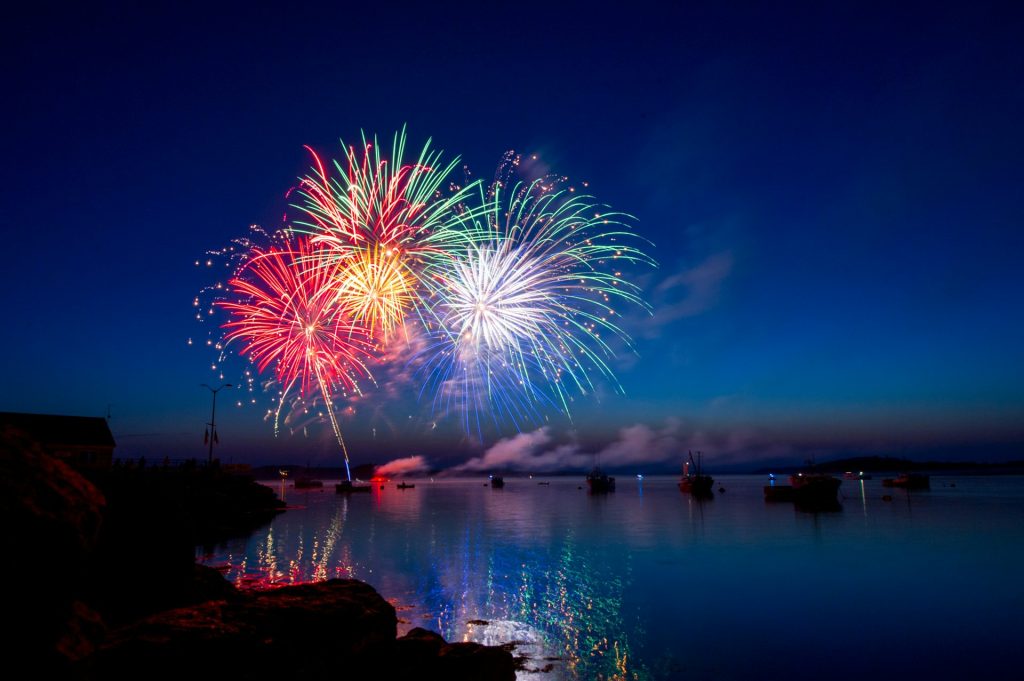
Summer brings Japan’s most energetic festival season with colorful celebrations featuring distinctive regional characteristics tied to historical and agricultural traditions.
Major Summer Matsuri
July and August feature Japan’s most spectacular festivals, many originating from ancient practices to honor ancestors or appease local deities.
Spectacular Summer Celebrations:
- Gion Matsuri (Kyoto): Thousand-year-old festival running throughout July. Massive yamaboko floats parade through Kyoto on July 17th and 24th. Evening yoiyama events transform downtown into pedestrian zones with food stalls and traditional entertainment. Sacred mikoshi processions represent the spiritual core of this ancient celebration.
- Nebuta Matsuri (Aomori): Early August festival featuring enormous illuminated lantern floats depicting warriors and mythical characters. Accompanied by taiko drummers and thousands of haneto dancers chanting “Rassera!” Visitors can watch or join dancers with rental costumes. Culminates with floats being released into Aomori Bay.
- Awa Odori (Tokushima): 400-year-old “fool’s dance” festival held mid-August. Male dancers perform in low, crouched stances while women dance with graceful upturned hands. All accompanied by shamisen, flutes and drums. Features designated areas where visitors can join in the dancing to experience this rhythmic tradition firsthand.
Regional Summer Specialties
Beyond nationally famous events, summer features regional celebrations showcasing unique local traditions and crafts.
Distinctive Regional Festivals:
- Tenjin Matsuri (Osaka): One of Japan’s three greatest festivals, held July 24-25. Features a land procession with costumed participants and mikoshi shrines, followed by a river parade with illuminated boats on the Okawa River. Over 100 boats carry musicians, dancers and portable shrines through Osaka’s waterways. Concludes with spectacular fireworks display lighting the night sky.
- Tanabata Celebrations: Star Festival celebrated primarily on July 7 (or August 7 in some regions). Based on the romantic legend of separated lovers Orihime and Hikoboshi who meet once yearly. Colorful paper decorations and handwritten wishes on tanzaku strips adorn bamboo branches nationwide. Major celebrations in Sendai (August), Hiratsuka and Shonan feature elaborate street decorations and parades.
- Fireworks Competitions: Summer evenings illuminate with hanabi (fireworks) festivals throughout July and August. Tokyo’s Sumida River Fireworks features 20,000+ pyrotechnic bursts. Nagaoka Festival displays unique wide-starmine formations. Omagari National Fireworks Competition in Akita showcases Japan’s best pyrotechnicians competing with innovative designs. Many viewers don yukata and reserve riverside viewing spots hours in advance.
Autumn Events: Harvest and Foliage
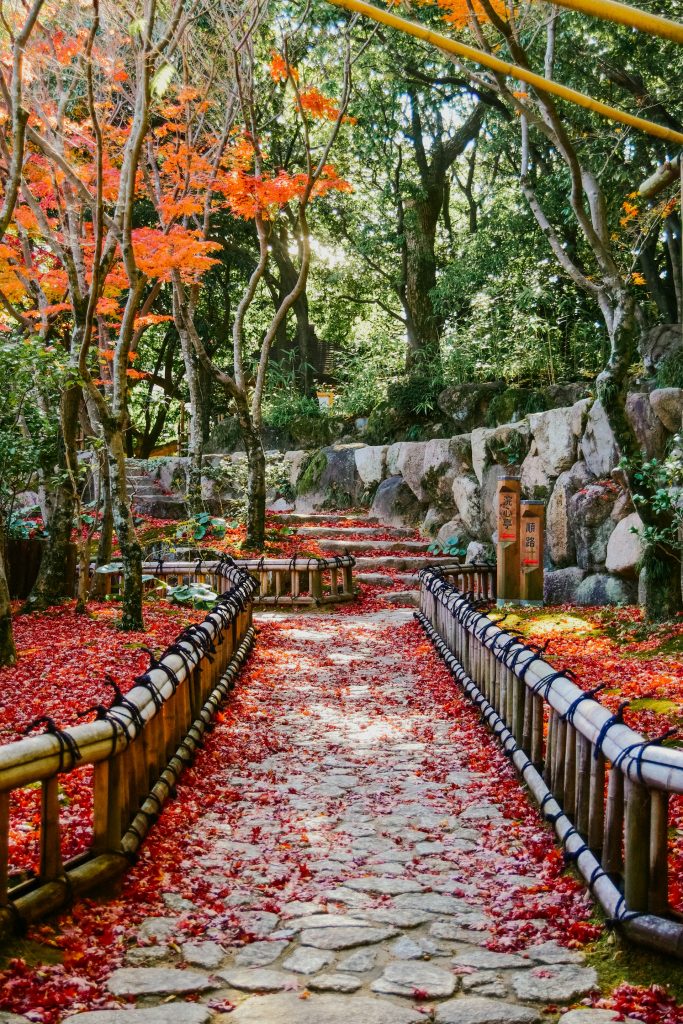
Autumn combines spectacular natural scenery with traditional harvest celebrations, creating Japan’s most photogenic season beyond cherry blossoms.
Koyo (Autumn Leaves) Experiences
Japan’s autumn foliage offers visual spectacle comparable to cherry blossom season but lasting significantly longer, with specialized viewing opportunities nationwide.
Autumn Foliage Insights:
- Extended Viewing Season: Japan’s autumn colors cascade from north to south between September and December. Hokkaido’s leaves begin changing in mid-September, central Japan transforms mid-October through November, while southern regions like Kyushu peak in late November to early December. This geographical progression creates a three-month viewing window for planning your koyo (autumn leaves) experience.
- Peak Viewing Locations: Kyoto’s temples showcase spectacular maple displays, particularly at Tofukuji, Eikando and Arashiyama. For mountain vistas, Nikko National Park offers stunning panoramas around Lake Chuzenji. Tokyo’s Rikugien Garden creates perfect reflection scenes with its traditional landscape. Korankei Gorge in Aichi Prefecture features over 4,000 maple trees planted since the 17th century along the Tomoe River.
- Illumination Experiences: Special evening light-ups transform autumn landscapes at select locations. Kyoto’s Kiyomizudera Temple and Tokyo’s Rikugien Garden extend hours with dramatic illuminations highlighting vibrant leaves against dark skies. Hakone’s Gora Park creates magical nighttime ambiance with strategically placed lighting enhancing the natural colors of maple and ginkgo trees.
- Crowd Management: Visit popular sites on weekdays and early mornings to avoid peak crowds. Consider lesser-known locations like Kamakura’s Engakuji Temple or Yamadera in Yamagata Prefecture. Some gardens implement timed entry tickets during peak season – reserve online when possible. Transportation can become congested; purchase train tickets in advance and consider staying overnight near popular viewing areas rather than attempting day trips.
Harvest and Cultural Festivals
Autumn features traditional celebrations connected to agricultural cycles and cultural heritage, many preserving practices dating back centuries.
Significant Autumn Celebrations:
- Takayama Autumn Festival: Held October 9-10 at Hachiman Shrine. Features eleven ornate yatai floats paraded through historic streets, some with intricate karakuri puppet performances. Evening processions include hundreds of lanterns illuminating the antique floats. One of Japan’s most beautiful traditional festivals set against the backdrop of early autumn colors in this mountain town.
- Jidai Matsuri (Kyoto): “Festival of Ages” occurs October 22nd with a historical procession representing 1,000 years of Kyoto’s history. Over 2,000 participants wear meticulously recreated costumes from various historical periods, chronologically parading from the Imperial Palace to Heian Shrine. Commemorates Kyoto’s historical significance as Japan’s former capital, perfectly timed with early autumn colors.
- Kurama Fire Festival: Dramatic fire ritual held October 22nd in the mountain village of Kurama. Dating back 1,200 years, the festival begins at dusk when villagers carry flaming torches through narrow streets. Reaches climax when huge kagaribi bonfires illuminate Yuki Shrine and giant torches up to 5 meters tall are paraded through town, all accompanied by shouts of “sairē, sairē” from participants in traditional costumes.
Winter Illuminations and Celebrations
Winter transforms Japan with unique festivals combining traditional celebrations, modern illuminations, and distinctive seasonal activities unavailable during warmer months.
Snow Festivals and Winter Celebrations
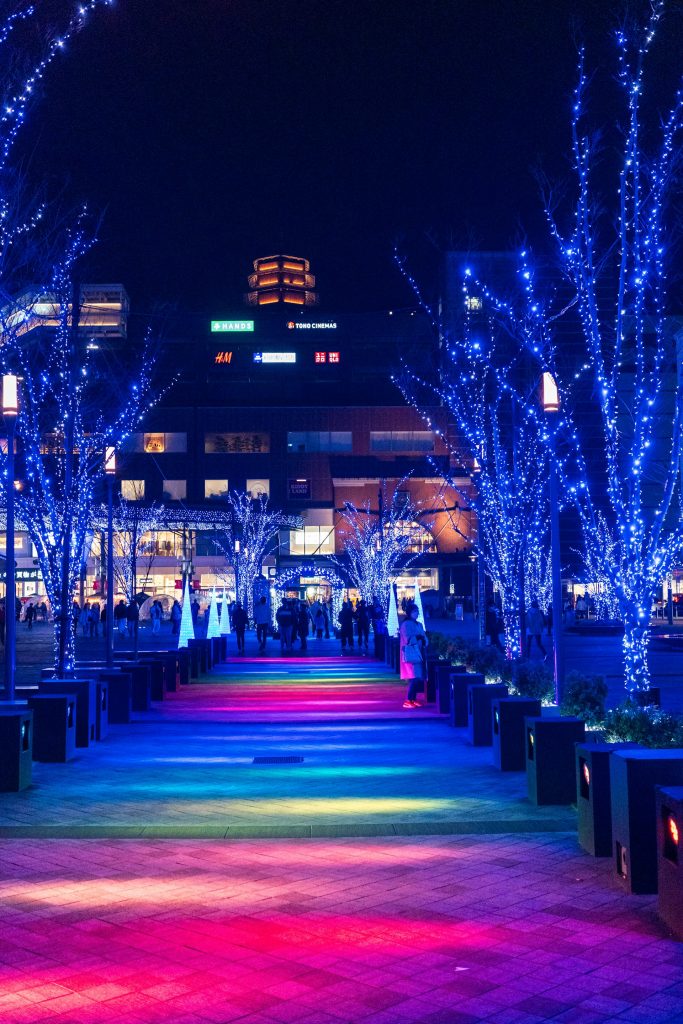
Japan’s northern regions have developed world-renowned winter celebrations showcasing snow and ice as artistic mediums.
Winter Festival Highlights:
- Sapporo Snow Festival: Held early February in Hokkaido’s capital city. Features over 200 massive snow and ice sculptures in Odori Park, Susukino, and Tsudome sites. International teams create intricate artistic masterpieces and architectural replicas, some reaching 15 meters high. Illuminated sculptures at night create magical winter wonderland. Attracts over 2 million visitors annually with food stalls serving local specialties like ramen and crab dishes.
- Yokote Kamakura Festival: Two-day celebration in February featuring snow domes (kamakura) throughout Yokote City in Akita Prefecture. These igloo-like structures house small altars dedicated to water deities. Local children invite visitors inside to enjoy amazake (sweet rice drink) and mochi rice cakes around charcoal braziers. Hundreds of mini-kamakura with candles line the riverbanks, creating a mesmerizing nighttime display in this 450-year-old tradition.
- Nozawa Onsen Fire Festival: One of Japan’s most intense winter festivals held January 15th in this historic ski village. Centers around a massive wooden shrine called shaden that local men defend while others attempt to burn it down. Fueled by sake and shouting, the battle culminates when the structure is finally set ablaze. Celebrates the protection of young children and good harvest in the coming year. Experience this primal fire ceremony while enjoying the village’s natural hot springs.
Seasonal Illumination Events
Japan has developed spectacular winter illumination experiences that transform parks, gardens, and urban areas into fantastical light displays.
Must-See Winter Illuminations:
- Nabana no Sato: Located in Mie Prefecture, this botanical garden creates Japan’s most elaborate winter light installation with over 8.5 million LED bulbs. Electrical engineering specifications document the display requiring specialized power infrastructure delivering 1.2 megawatts during peak operation.
- Kobe Luminarie: Established as a memorial following the 1995 Great Hanshin Earthquake, this installation utilizes 200,000+ hand-painted lights mounted on 200+ Italian-designed architectural frameworks. Historical records confirm the annual design process begins 10 months before installation.
- Tokyo Midtown Christmas: Urban planning studies identify this as Tokyo’s most sophisticated projection mapping display, utilizing 65 high-definition projectors to transform building facades into dynamic seasonal displays synchronized to original musical compositions.
